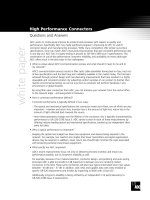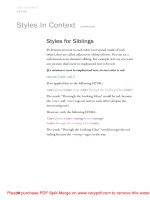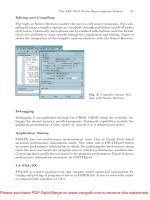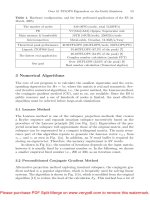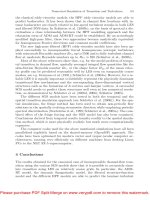Tài liệu High Performance Driver P3 doc
Bạn đang xem bản rút gọn của tài liệu. Xem và tải ngay bản đầy đủ của tài liệu tại đây (98.59 KB, 10 trang )
HIGH PERFORMANCE DRIVES
---------------------------------------------------------------------------------------------------------------------------------------
E Levi, 2001
41
3. ROTOR FLUX ORIENTED CONTROL OF INDUCTION MACHINES
3.1. FIELD ORIENTATION POSSIBILITIES IN INDUCTION MACHINES
Decoupled flux and torque control of an induction machine can be realised by control of instantaneous
phase current values, which in turn can be achieved by stator current space vector magnitude and
position control with respect to the chosen flux space vector. As already discussed in the Section 2.3.3.,
a vector is composed of appropriate d-q axis components, d-axis component being the real part and q-
axis component being the imaginary part of the vector (i.e. d-q axes are mutually perpendicular, as
already emphasised). Stator current space vector can be orientated with respect to space vector of rotor
flux, stator flux or air gap flux and machine can be fed from either voltage or current type source.
Comparative analysis of different orientation possibilities reveals the main reasons for prevailing
application of current-fed induction machines with rotor flux oriented control. If the decoupled flux and
torque control are to be achieved in an induction machine by means of either stator flux or air gap flux
oriented control, an appropriate decoupling circuit has to be inserted in the control part of the system,
regardless of whether the machine is fed from a voltage or a current type source. A similar conclusion
is valid for a voltage-fed induction machine with rotor flux oriented control.
Orientation along air gap flux space vector has been a rarely discussed and applied orientation
possibility until recently. Orientation along stator flux remained as well beyond the scope of interest for
a long time. Recent advancement in development of microprocessors and DSPs enables however
significantly easier implementation of decoupling circuits. As a consequence, an increase in amount of
research devoted to these two orientation methods has occurred recently, with emphasis on orientation
along stator flux. If the flux space vector is to be estimated from measured values of stator currents and
stator voltage, then the stator flux can be estimated more accurately than the rotor flux, due to inevitable
parameter variation effects in the machine. This is exactly the vector control scheme where orientation
along stator flux is suggested to be a better solution than the rotor flux orientation. If the machine is of
such a design that rotor slots are closed, orientation along stator flux becomes especially advantageous.
The variation of rotor leakage inductance in machines with closed rotor slots can be very significant and
can cause even static instability if rotor flux oriented control is applied. More specifically, pull-out
torque, which is theoretically infinite in the absence of parameter variations, is a function of rotor
leakage inductance and if it is reduced to such a level that maximum allowed torque exceeds its value,
static instability will result. On the contrary, with orientation along stator flux pull-out torque always
has finite value which is however not affected by rotor leakage inductance variations. Therefore
stability problems can be avoided by appropriate design of the torque controller limit. Very much the
same discussion and conclusions apply for the field-weakening region as well. If there are no parameter
variations, orientation along stator flux with appropriate decoupling circuit can provide the same quality
of dynamic response as the rotor flux oriented control. However, if there are parameter variations,
stator flux oriented control becomes superior. All the previous remarks are restricted to the case when
flux estimation is performed by means of measured stator voltages and currents.
The most advanced achievement in field oriented control of induction machines is the universal vector
controller (UFO), which enables realisation of orientations along stator, air gap and rotor flux.
Different orientation types and appropriate decoupling circuits are available. Universal vector
controller enables combined application of indirect and direct vector control methods with orientations
along rotor, air gap and stator flux in different operating regimes. A possible combination suggested
consists of indirect rotor flux oriented control in low speed region and direct stator flux oriented control
in high speed and field-weakening region (the notions of indirect and direct vector control will be
explained shortly).
HIGH PERFORMANCE DRIVES
---------------------------------------------------------------------------------------------------------------------------------------
E Levi, 2001
42
Wider application of universal vector controllers with combined orientation schemes is however not
likely to take place in the near future. Of far the greatest importance is still rotor flux oriented control
of a current-fed induction machine, as it offers both theoretically ideal dynamic response and the
simplest realisation. This vector control scheme has become during the last five years an industrial
standard and there is at present a variety of commercially available drives that utilise the principle of
indirect rotor flux oriented control of a current-fed induction machine.
Notions of indirect and direct vector control were introduced in the preceding paragraph and they ask
for further clarification. These terms are related to the way in which orientation is achieved but they are
not related to any specific choice of flux along which orientation is performed. Different subdivisions of
vector control techniques on direct and indirect methods are available. As will be shown in the next
Section, vector control requires precise knowledge of the instantaneous angular position of the selected
flux space vector. Conventional approach groups together as direct methods all the methods which
utilise some measured data related to either terminal or magnetic variables (air gap flux, stator currents
and voltages) for flux space vector position calculation. In the sense of this definition, indirect vector
control schemes perform calculation of flux space vector position without any measurement of
electromagnetic variables. Commanded axis currents enable calculation of angular slip frequency
which is later on used together with measured rotor speed (position) to produce an estimate of flux
position. Indirect and direct vector control defined in this way are often termed as feed-forward and
feedback control, respectively. Notions of indirect and direct field oriented control will be used
according to this subdivision. Summarising, indirect vector control methods here are those that utilise
reference values of induction motor variables for calculation of rotor flux space vector position (plus
measured speed or position), while direct methods perform the same calculation by using measured
electro-magnetic variables, and, if necessary, measured rotor speed or position. Methods of direct and
indirect rotor flux oriented control will be discussed in detail in Section 3.3.
Only rotor flux oriented control is elaborated in what follows. Current-fed induction machine is treated
first. This is followed by analysis of the voltage-fed induction machine. One important aspect of the
discussion that follows is related to the power supply. As emphasised in Section 2.4., an ideal variable
magnitude, variable frequency sinusoidal voltage source does not exist and an inverter has to be used
instead. This is however just an unavoidable nuisance which has no consequences on the principals of
the vector control. Vector control theory is developed under the assumption of ideal sinusoidal supply
under all operating conditions. This means that the control is related to the fundamental harmonic of the
supply in the inverter case. The fact that the inverter supply produces higher order voltage harmonics as
well does not influence in any way the principles of vector control. The presence of higher order voltage
harmonics in the supply simply means that the currents of the machine and the torque contain higher
order harmonics as well. While these do adversely affect the behaviour of the machine (additional losses
and heating, torque ripple, reduced efficiency), they do not affect the control. Hence the control system
of any vector controlled drive essentially generates current (or voltage) references that are in any steady-
state operation pure sine waves. The complete theory of vector control that follows in Section 3.2.
assumes that the machine is supplied from a pure sinusoidal voltage source.
3.2. ROTOR FLUX ORIENTED CONTROL
3.2.1. Current fed induction machine
As already noted, if the machine is regarded as current-fed the stator currents can be treated as known
and, under ideal conditions, equal to their reference values. In other words,
ii ii ii
aa b bcc
***
===
(3.1)
where the asterisk denotes reference (required) phase current values generated by the control system,
while current values without an asterisk are those in the machine. Equation (3.1) applies to any instant
HIGH PERFORMANCE DRIVES
---------------------------------------------------------------------------------------------------------------------------------------
E Levi, 2001
43
in time and cannot be ever fully satisfied in reality. However, by using current control of a VSI, one
approaches this ideal situation. The methods of current control of a VSI are beyond the scope of interest
at present and are discussed in detail in Chapter 5.
From the preceding discussion it follows that the output of the control system are phase current
references. Recall that the same was said in Chapter 1 in conjunction with armature current of a high
performance separately excited DC motor drive. Since the stator currents are known, there is no need to
consider stator voltage equations for realisation of the control scheme. In order words, stator voltage
equation of the model (2.36) can be omitted from consideration. This is obviously a simpler case than
when stator voltage equation has to be considered as well, as the case is with rotor flux oriented control
of a voltage-fed induction machine.
The model (2.36) is given in the arbitrary reference frame and is repeated here once more for
convenience:
vRi
d
dt
jRi
d
dt
j
s
s
s
s
a
s
r
r
r
a
r
=+ + =+ + −
ψ
ωψ
ψ
ωωψ
0()
ψ ψ
s
s
s
m
r
r
r
r
m
s
Li L i Li L i=+ =+
}
TP
L
L
i
e
m
r
s
r
=
ì
í
î
3
2
Im
ψ
(2.36)
() ()
vv jv ve ii ji ie
s
ds qs s
j
s
ds qs s
j
ss ss
=+ = =+ =
−−
βθ εθ
The clue to vector control consists in selection of the speed of the common reference frame. For rotor
flux oriented control the speed of the reference frame is selected as equal to the speed of rotation of the
rotor flux space vector at all times. The real axis of the reference frame, d-axis, is at all times aligned
with the rotor flux space vector, while the q-axis is perpendicular to it. As the common reference frame
is fixed to the rotor flux space vector and moreover, as the d-axis (real axis) of the common reference
frame coincides with rotor flux space vector, then
θ φ θ φ θ
ωω ω
φ
sr rr
ar r
r
d
dt
==−
==
(3.2)
Rotor flux space vector, Eq. (2.34), becomes a pure real variable in this special frame of reference,
ψ ψ ψ ψ
r
dr qr r
j=+ =
(3.3a)
i.e., it follows that
ψ ψ ψ ψ
dr r qr qr
dt== =d00
. (3.3b)
Rotor flux and stator current space vectors in the common reference frame fixed to the rotor flux space
vector are illustrated in Fig. 3.1.
Taking into account Eq. (3.3), torque equation of (2.36) takes, using the stator current space vector
equation of (2.36), the following form:
{}
TP
L
L
iP
L
L
i
e
m
r
r
s
m
r
rqs
==
3
2
3
2
ψψ
Im
(3.4)
Torque equation (3.4) is of the same form as the torque equation met in DC machine theory (see
equation (1.4)) and it shows that, if the magnitude of the rotor flux is kept on constant value, torque can
be independently controlled by stator q-axis current.
In order to accommodate rotor voltage equation (2.36) to the chosen reference frame, rotor current
space vector has to be expressed from the rotor flux linkage equation of (2.36) (note that Eq. (3.3) is
HIGH PERFORMANCE DRIVES
---------------------------------------------------------------------------------------------------------------------------------------
E Levi, 2001
44
accounted for and hence the rotor flux space vector is a real quantity; it is therefore not underlined any
more):
q-axis
(Im)
ω
r
i
s
ε
s
−φ
r
ψ
r
d-axis
φ
r
(Re)
ε
s
θω
A-axis
a-axis
Fig. 3.1 - Illustration of space vectors in common reference frame fixed to the rotor flux space vector.
()
iLiL
r
rm
s
r
=−
ψ
/
(3.5)
Substituting (3.5) into rotor voltage equation of (2.36) and taking into account (3.2), the following rotor
voltage equation results:
0
11
=++−−
T
d
dt
j
T
Li
r
r
r
rr
r
m
s
ψ
ψ
ωωψ
()
(3.6)
where T
r
= L
r
/R
r
is the rotor time constant. Separation of (3.6) into real and imaginary part yields
ψ
ψ
rr
r
mds
T
d
dt
Li+=
(3.7)
()
ω ω ψ
rrrmqs
TLi−=
(3.8)
Equation (3.7) reveals that, in this special common reference frame fixed to the rotor flux space vector,
magnitude of rotor flux can be controlled by stator d-axis current and that magnitude of rotor flux is
constant if the stator d-axis current is constant. According to Eq. (3.8), angular slip frequency
ω ω ω
sl r
=−
is linearly dependent on stator q-axis current if the magnitude of rotor flux is constant.
Consequently, developed torque is proportional to slip frequency. If the stator d-axis current is held
constant, torque can be instantaneously altered if it is possible to change stator q-axis current
instantaneously. Note that there is no pull-out torque (i.e., pull-out torque is theoretically infinite) and
any desired value of the torque can be obtained by applying appropriate value of the stator q-axis
current, while maintaining the constant rotor flux. Illustration of flux and torque production in a current
fed rotor flux oriented induction machine is given in Fig. 3.2. From Fig. 3.2 it directly follows that rotor
flux amplitude is controllable by stator d-axis current component only (as excitation flux can be
controlled in a DC machine by excitation winding current) while for constant flux operation torque
depends on stator q-axis current component only (which corresponds to armature current in a DC
machine). The principle difference is however that in an induction machine both d- and q-axis stator
current components are actually parts of the same stator current vector, while in a DC machine
excitation and armature current are completely independent.
If the machine is current-fed, stator voltage equations can be omitted from consideration and the
equations derived so far constitute the complete model of a rotor flux oriented induction machine.
Equations (3.4), (3.7) and (3.8) show that decoupled torque and flux control can be obtained with a
HIGH PERFORMANCE DRIVES
---------------------------------------------------------------------------------------------------------------------------------------
E Levi, 2001
45
current-fed machine in rotor flux oriented reference frame. Difficulties experienced in practical
analogue realisations, before the microprocessor era, are a consequence of the need to perform co-
ordinate transformation from rotational to stationary reference frame. The control system has to operate
in rotor flux oriented reference frame if decoupled control is to be achieved, while actual machine
operates in stationary phase domain. A schematic representation of a current-fed induction machine
with rotor flux oriented control is given in Fig. 3.3. Block CRPWM denotes current regulated PWM
inverter, speed drive is shown, and provision for operation in field-weakening region is included. Closed
loop current control is not explicitly shown in Fig. 3.3: however, it is contained within the block
CRPWM, that ensures that Eq. (3.1) is (approximately) satisfied. Closed loop speed control is of course
present. Hence the situation is the same as in a separately excited DC machine: the inner current control
loop is contained within the outer speed control loop and measurement of currents and the speed is
required. Note that all the variables associated with the control system have an asterisk, while those
without an asterisk are the variables within the machine. The configuration of the drive displayed in
Fig. 3.3 corresponds to category of direct orientation schemes (superscript ‘e’ in the transformation
block indicates that an estimate of the rotor flux space vector position is used for co-ordinate
transformation). Structures of rotor flux estimators are dealt with in Section 3.3.
i
a
i
αs
i
ds
1
ψ
r
L
m
i
b
3 −jφ
r
1+sT
r
e
i
c
2i
βs
i
qs
L
m
ω
sl
T
r
φ
r
3P L
m
T
e
P ω
2L
r
Js
T
L
ω
r
1
s
Fig. 3.2 - Block diagram of an ideal current fed rotor flux oriented induction machine (note that if
stator d-axis current is constant rotor flux is constant and torque depends on stator q-axis current
only). Friction torque is neglected and s represents Laplace operator.
signals
ω
*
ψ
r
-
-
-
Field
contr.
contr.
T
e
*
i
qs
*
i
ds
e
φ
r
e
ω
j
2
3
IM
ω
i
i
i
i
i
i
a
b
cc
b
a
ψ
r
T
e
φ
r
i
i
i
ω
a
b
c
rotor flux
C
R
P
W
M
**
*
*
*
Calculation of
vector ψ
r
from motor
Torque
Flux
weak.
Speed
contr.
i
i
*
*
α
β
s
s
Ideal CRPWM:
i
a
*=
i
a
i
b
*=
i
b
i
c
*=
i
c
Fig. 3.3 - Control of a current-fed direct rotor flux oriented induction machine: the scheme for
operation in both the base speed region and the field weakening regions is shown.

